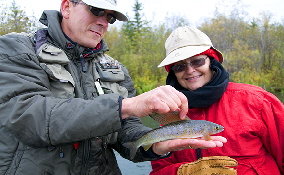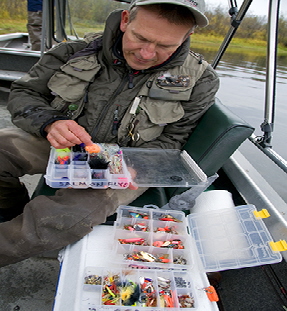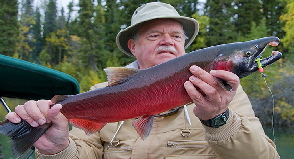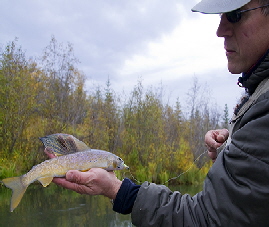|
Alaska's Nenana River Grayling & Salmon
By Larry Larsen
A light frost clung to the grass clumps beside the road as we headed for the launch ramp just one mile
away from our Nenana highway meeting point with guide Reed Morisky of the Arctic Grayling Guide Service/Wilderness Fishing, Inc. Soon my wife and I, along with two other anglers and Reed
 were blasting off upstream in the guide's large jet boat. The Nenana River
was roily and muddy but we were braving the chilly weather for the remote, spring-fed grayling fisheries off the Tanana River near Fairbanks. were blasting off upstream in the guide's large jet boat. The Nenana River
was roily and muddy but we were braving the chilly weather for the remote, spring-fed grayling fisheries off the Tanana River near Fairbanks.
We entered a small clear tributary and motored upstream about
7 miles before we came across two major forks. We started fishing the latter, tannin-stained due to run off from a series of beaver ponds full of rotten vegetation and other organic. There
were a lot of visible bugs on the surface and many also on the bottom and the grayling really like such forage, according to Reed.
 "The grayling are in the two creeks all summer long," he explained. "They are in here when the ice goes out at the end
of April or mid-May, and then in early October, they start migrating out into the big river. and over winter there around the Yukon. They say they are in a state of suspended
animation holding in the current and living off their reserves and doing some feeding for three or four months." "The grayling are in the two creeks all summer long," he explained. "They are in here when the ice goes out at the end
of April or mid-May, and then in early October, they start migrating out into the big river. and over winter there around the Yukon. They say they are in a state of suspended
animation holding in the current and living off their reserves and doing some feeding for three or four months."
Within 5 casts, I had my first grayling ever. Lilliam picked up
one shortly thereafter and we caught and released another half dozen in the 8 to 15 inch range in the following hour. The fish are small but lots of fun and the environment makes for a
memorable day on the beautiful waterway. Grayling is catch and release in this remote area and that is self-imposed by Reed.
"The limit here is 5 but we have found that an informal poll
with our clients they would rather catch a great number of fish than keep 5," he says. "The biologists are finding these fish are so old - some are 30 years old, and if people are
keeping them, the numbers will have to drop. Fortunately, I'm the only guide service working this area."
 The Alaska grayling record is about 22 inches long and 5 pounds 1 ounce taken from waters in the Nome region. The largest in the two
creeks that Reed fishes was 18-1/2 inches long, according to the guide. The Alaska grayling record is about 22 inches long and 5 pounds 1 ounce taken from waters in the Nome region. The largest in the two
creeks that Reed fishes was 18-1/2 inches long, according to the guide.
"Nome is right on the coast and has a few more salmon runs there,"
he explains. "That equates to how much food the grayling have. The salmon eggs really bulk them up and that's why in Bristol Bay (the
Nome area), the grayling are bigger; ours are slender and more sculpted."
Reed then took us down to a nearby creek for some silver salmon
fishing. We could see the red shapes of the male silvers move about the clear water but they were a little skittish. Finally, using one of
Reed's "Christmas ornament" flies, I landed one about 8 or 10 pounds. That was the end of our fishing that morning.
According to the guide, the salmon runs on the Nenana tributaries
start with the kings in July and they run to mid August. The chum salmon come in with the kings sometimes and there are pretty good
numbers of them. The chums normally taper off in August a couple of weeks after the kings are done, and
then around early September the coho and another run of chums come in with the silvers. They go until ice
out around mid-October. As a result, Reed offers a total of about 6 weeks of fishing for silvers and chums in the fall. He releases all female salmon.
 The chums generally run from 6 to 8 pounds with an occasional 10 or 11 pounder while the kings average 12 to 14
pounds. The Fairbanks-based guide has caught them as large as 20 pounds or more and his clients have taken a few in the 30-pound range. The top lures for kings are 7 /8 ounce pixies,
inline spinners. Many also use flies because it can be very productive and Reed's favorite is a gaudy one that looks like a Christmas ornament with lots of tinsel. The chums generally run from 6 to 8 pounds with an occasional 10 or 11 pounder while the kings average 12 to 14
pounds. The Fairbanks-based guide has caught them as large as 20 pounds or more and his clients have taken a few in the 30-pound range. The top lures for kings are 7 /8 ounce pixies,
inline spinners. Many also use flies because it can be very productive and Reed's favorite is a gaudy one that looks like a Christmas ornament with lots of tinsel.
"They really seem to like how the light reflects off it and how
it waves in the current," brags the guide. "Every year,
 I add more tinsel and they like that. For chums, flies and spinners with yellows, greens and orange yarns and fluorescent chartreuse
blades are productive. A lot of people over the past 10 years in Alaska seem to think green is the color. I've heard they eat a yellow-green algae in the ocean." I add more tinsel and they like that. For chums, flies and spinners with yellows, greens and orange yarns and fluorescent chartreuse
blades are productive. A lot of people over the past 10 years in Alaska seem to think green is the color. I've heard they eat a yellow-green algae in the ocean."
With salmon though, it is always wise to vary you offering and
presentations. As Reed advises, If after 20 minutes, nothing is happening, then change. For more information on a great trip, visit www.wildernessfishing.com or contact outfitter/guide Reed Morisky at 907-479-0479 or email to guide@wildernessfishing.com.
|